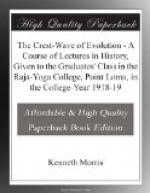And the meaning of it all? Well, the meaning is as vast as the scheme of evolution itself, I suppose. It is Hamlet over again, and treated differently; that which wrote Hamlet through Shakespeare, wrote this Trilogy through Aeschylus. I imagine you are to find in the Agamemnon the symbol of the Spirit’s fall into matter—of the incarnation (and obscuration) of the Lords of Mind—driven thereto by ancient Karma, and the result—of the life of past universes. Shakespeare deals with this retrospectively, in the Ghost’s words to Hamlet on the terrace. The ‘death’ of the Spirit is its fall into matter.
And just as the ghost urges Hamlet to revenge, so Apollo urges Orestes; it is the influx, stir, or impingement of the Supreme Self, that rouses a man, at a certain stage in his evolution, to lift himself above his common manhood. This is the most interesting and momentous event in the long career of the soul: it takes the place, in that drama of incarnations, that the marriage does in the modern novel. Shakespeare, whose mental tendencies were the precise opposite of Aeschylus’s—they ran to infinite multiplicity and complexity, where the other’s ran to stern unity and simplicity (of plot)—made two characters of Polonius and Gertrude: Polonius,—the objective lower world, with its shallow wisdom and conventions; Gertrude,—Nature, the lower world in it subjective or inner relation to the soul incarnate in it. Aeschylus made no separate symbol for the former. Shakespeare makes the killing of Polonius a turning-point; thenceforth Hamlet must, will he nill he, in some dawdling sort sweep to his revenge. Aeschylus makes that same turning-point in the killing of Clytemnestra, whereafter the Furies are let loose on Orestes. If you think well what it means, it is that “leap” spoken of in Light on the Path, by which a man raises himself “on to the path of individual accomplishment instead of mere obedience to the genii which rule our earth.” He can no longer walk secure like a sheep in the flock; he has come out, and is separate; he has chosen a captain within, and must follow the Soul, and not outer convention. That step taken, and the face set towards the Spirit-Sun—the life of the world forgone, that a way may be fought into the Life of the Soul:—all his past lives and their errors rise against him; his passions are roused to fight for their lives, and easy living is no longer possible. He must fly then for refuge to Loxias the Sun-God, the Supreme Self, who can protect him from these Erinyes—but it is Pallas, Goddess of the Inner Wisdom, of the true method of life, that can alone set him free. And it is thus that Apollo pleads before her for Orestes who killed his mother (Nature) to avenge his Father (Spirit):—a man, says he, is in reality the child of his father, not of his mother:—this lower world in which we are incarnate is not in truth our parent or originator at all, but only the seed-plot in which we, sons of the Eternal, are sown, the nursery in which we grow to the point of birth;—but we ourselves are in our essence flame of the Flame of God. So Pallas—and you must think of all she implied—Theosophy, right living, right thought and action, true wisdom—judges Orestes guiltless, sets him free, and transforms his passions into his powers.




